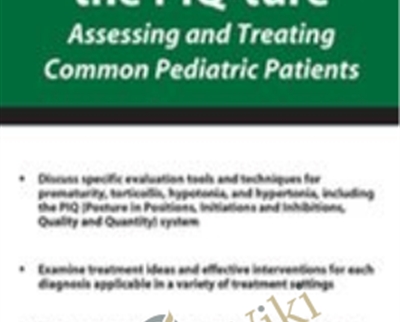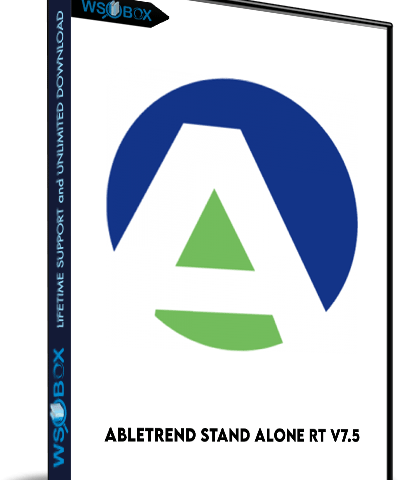Getting the PIQ-ture Assessing and Treating Common Pediatric Patients – Michelle Fryt Linehan
$77.00
5 Hours 43 Minutes
This recording will help attendees choose the best assessment tool (standardized and non-standardized) for each patient and get a comprehensive picture of the patient by using an orderly approach for general observations (PIQ-ture). Goal-setting and treatment ideas will be discussed for each type of patient, noting differences between "evidence-based" treatment ideas and standard protocols used.
Description
Purchase Getting the PIQ-ture Assessing and Treating Common Pediatric Patients – Michelle Fryt Linehan Course at eBokly. We actively participate in group buys and are committed to sharing knowledge with a wider audience. What's more, our courses maintain the same quality as the original sale page. You have the option to buy directly from the sale page at the full price (sale page link is provided within the post).
Evaluation and Treatment Plans for Common Pediatric Musculoskeletal and Movement Problems
With the rising incidence of cerebral palsy, survival of the tiniest premature infants, and the increased incidence of torticollis, any professionals working with children in an inpatient, outpatient, school, or home environment will undoubtedly be asked to assess and treat children with movement and neuromuscular disorders. A diagnosis of "cerebral palsy" or "developmental delay" is very general and professionals who are asked to treat a child with one of these or other general diagnoses must have a good understanding of the evaluation tools and treatment options that will guide the provision of an individualized, safe, and effective program for each child.
This recording will help attendees choose the best assessment tool (standardized and non-standardized) for each patient and get a comprehensive picture of the patient by using an orderly approach for general observations (PIQ-ture). Goal-setting and treatment ideas will be discussed for each type of patient, noting differences between "evidence-based" treatment ideas and standard protocols used. Leave with many hands-on ideas that can be used immediately in the practice setting, as well as numerous resources and ideas for further study.
- Describe the assessment tools available for pediatric motor evaluations
- Identify assessment tools that are appropriate for use with specific pediatric patients
- Organize information gathered during an evaluation session into a comprehensive report
- Define and describe four common types of pediatric patients seen by motor therapists and school personnel
- Develop a treatment for each of the four types of pediatric patients: children with low tone, high tone, torticollis, and premature infants
- Implement the PIQ-ture assessment tool to complement and complete an evaluation of any pediatric patient
ASSESSMENT OF CHILDREN
- Issues with evaluation of children
- Lois Bly’s Motor Skills Acquisition Check List
- What to evaluate
- Choosing an evaluation tool
- Commonly used norm-referenced tools for general motor skill assessment
- Bayley Scales of Infant Development
- Peabody Developmental Motor Scales
- Movement ABC
- Bruininks-Oseretsky Test of Motor Performance
- Re-evaluation with standardized assessments
- Commonly used criterion-reference pediatric assessment tools
- gross motor function measure (88 and 66)
- school function assessment
- goal attainment scale
- Gathering other pertinent information
- five senses
- the use of PIQ (Posture in Positions, Initiations and Inhibitions, Quality and Quantity)
- Evaluation components
- strength chart
- gait analysis
- Treatment planning
- use of left vs. right brain thinking
- PT/OT diagnoses vs. medical diagnoses
TORTICOLLIS
- Definition and incidence
- Causes
- Changes in developmental milestones with Back to Sleep
- Evaluation
- PIQ
- cranial measurements
- range of motion
- motor evaluation
- Intervention Ideas
- positioning
- range of motion
- case study
PREMATURITY
- Definition, incidence, morbidity, causes
- Long term sequella
- Dynamic systems theory
- Evaluation – subjective and objective information
- complications, feeding, physical aspects
- PIQ
- standardized assessments
- Intervention
- parental education
- supine vs. prone
- frequency, location
- case study
HYPOTONIA
- Definition and clinical characteristics
- Causes
- non-neurological
- central
- peripheral
- Weakness vs. joint laxity vs. low tone
- Assessing children with low tone
- INFANIB
- movement assessment of infants
- gross motor function measure
- PIQ
- range of motion
- sensation and perception – proprioception
- Intervention strategies—moving from diagnosis to treatment
- task analysis + noted impairments → treatment
- chart with treatment ideas
- Patricia Winder’s book
- case study
HYPERTONIA
- Definition and incidence
- spasticity vs. hypertonia
- classification system for cerebral palsy
- Assessing children with tone disorders
- past medical history
- orthopedic issues
- standardized assessments
- PIQ
- causes of in-toeing
- Ryder’s test
- strength, balance, sensation/perception
- Treatment ideas
- strengthening for children with hypertonia
- whole body vibration plate
- NDT
- constraint-induced movement therapy
- taping, stretching, NMES vs. TES
- Adaptive equipment
- PBWB
- standers
- orthotics
- Case study using chart for single goal
Tag: Getting the PIQ-ture Assessing and Treating Common Pediatric Patients – Michelle Fryt Linehan Review. Getting the PIQ-ture Assessing and Treating Common Pediatric Patients – Michelle Fryt Linehan download. Getting the PIQ-ture Assessing and Treating Common Pediatric Patients – Michelle Fryt Linehan discount.
Purchase the Getting the PIQ-ture Assessing and Treating Common Pediatric Patients – Michelle Fryt Linehan course at the best price at eBokly. Upon completing your purchase, you will gain access to the downloads page. where you can conveniently retrieve all associated course files. Additionally, we will send you a download notification email to your registered mail.
Unlock your full potential with our Getting the PIQ-ture Assessing and Treating Common Pediatric Patients – Michelle Fryt Linehan courses. Our courses are meticulously designed to empower you with the skills and knowledge needed for excellence.
Why wait? Take the first step towards greatness by acquiring our Getting the PIQ-ture Assessing and Treating Common Pediatric Patients – Michelle Fryt Linehan courses today. We ensure a smooth and secure purchasing experience that guarantees your peace of mind. Rest assured that your financial information is safeguarded through our trusted payment gateways, Stripe and PayPal.
Stripe, renowned for its robust security measures, offers a secure and dependable payment process. Your sensitive data is encrypted using state-of-the-art technology, ensuring its confidentiality throughout the transaction.
PayPal, a globally recognized payment platform, adds an extra layer of security. With its buyer protection program, you can make your purchase with confidence, knowing that your financial details are protected, allowing you to focus on your learning journey.
Is it secure? to Use of?
- Rest assured, your identity remains completely confidential. We do not share your information with anyone, ensuring the utmost security when you buy the Getting the PIQ-ture Assessing and Treating Common Pediatric Patients – Michelle Fryt Linehan course.
- 100% Safe Checkout Privateness coverage
- We employ robust communication and encryption methods to protect sensitive information. All card numbers are encrypted using AES at rest-256, and the transmission of card numbers occurs in a separate hosting environment, without sharing or storing any data.
How Will the Course Be Delivered?
- Upon successful payment for the “Getting the PIQ-ture Assessing and Treating Common Pediatric Patients – Michelle Fryt Linehan course”, Most of the products will come to you immediately. But for some products were posted for offer. Please wait for our response, it might take a few hours due to the time zone difference.
- If this occurs, kindly be patient. Our technical department will process the link shortly, and you will receive notifications directly via email. Your patience is greatly appreciated.
What Shipping Methods Are Available?
- You will receive a download link in the invoice or in YOUR ACCOUNT.
- The course link is always accessible. Simply log in to your account to download the Getting the PIQ-ture Assessing and Treating Common Pediatric Patients – Michelle Fryt Linehan course whenever you need.
- You can study online or download the content for better results, making it accessible from any device. Ensure your system does not go to sleep during the download process..
How Do I Track Order?
- We promptly update the status of your order following your payment. If, after 7 days, there is no download link provided, the system will automatically process a refund..
- We love to hear from you. Please don’t hesitate to email us with any comments, questions and suggestions.
You must be logged in to post a review.

 Purchase this course you will earn
Purchase this course you will earn 




Reviews
There are no reviews yet.